
Photo Credit: mimagephotography / Shutterstock
The U.S. job market has experienced some of the most volatile times in recent memory.
The onset of the COVID-19 pandemic forced many businesses across the country to close their doors and lay off employees, which brought about an unprecedented spike in unemployment. As economies reopened for business, unemployed workers faced a difficult job market and some turned to self-employment. Due in large part to necessity, recessions often see an increase in self-employment and entrepreneurship.
Self-employment can also be a more attractive option for those looking for flexibility with when and where they work. After nationwide employment rebounded, the job market dramatically shifted in the employee’s favor and portended the Great Resignation—the mass job-quitting phenomenon that began in the spring of 2021, where many workers left their employers for better opportunities and more flexible working conditions. Self-employment presented itself as a potential solution for many that were facing low pay, lack of opportunities for advancement, or even the lack of adequate child care.
The COVID-19 pandemic steered many workers to seek new opportunities, causing self-employment and entrepreneurship to expand and new business applications to reach record levels.
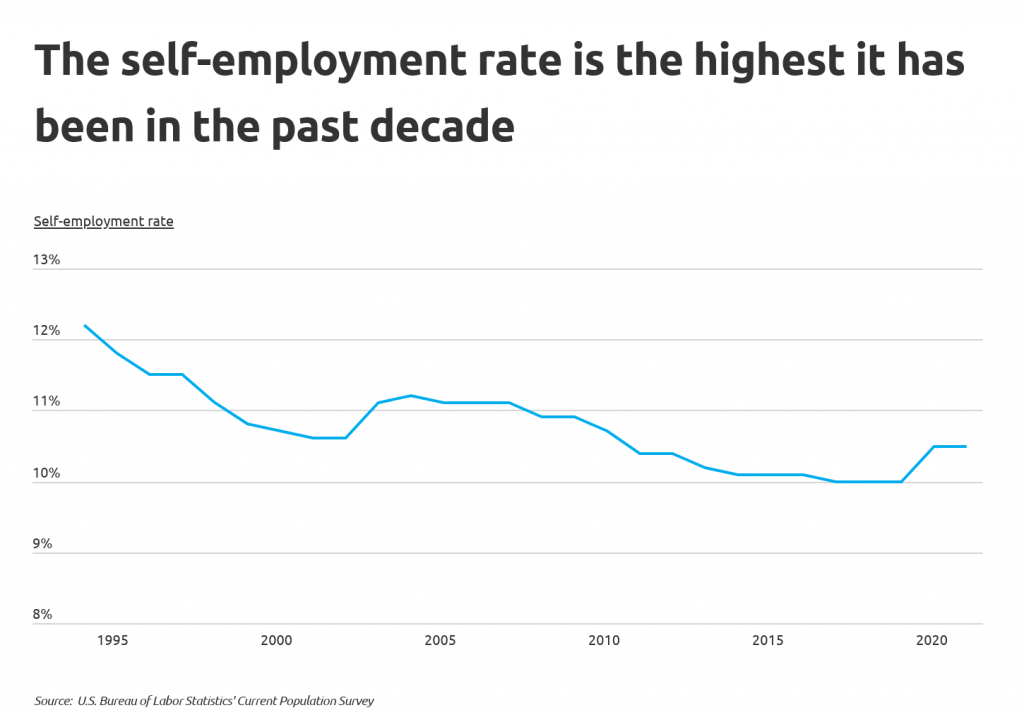
Prior to the pandemic, self-employment was on the decline and had been falling since 2004. When the economic shutdown occurred in the spring of 2020, nearly 22 million workers lost their jobs and the self-employment rate rose to 10.5%. The following year, workers began quitting their jobs at the highest rates since the Great Recession, and consequently, the self-employment rate held steady as some of those workers sought to start businesses.
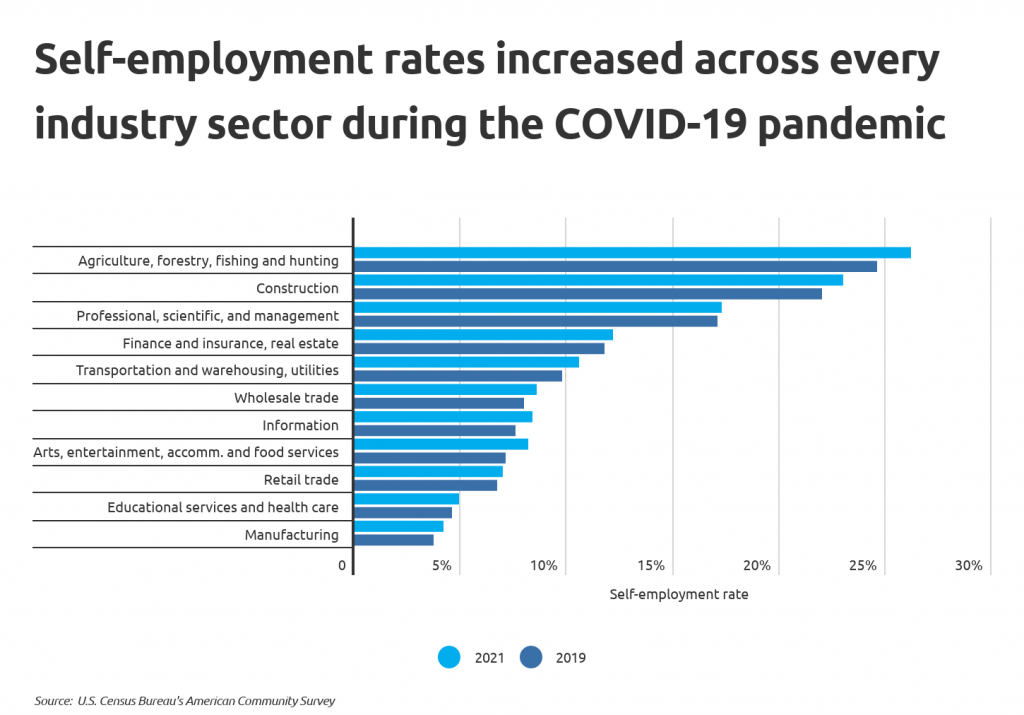
While some industries and occupations have much higher rates of self-employment, all industry sectors saw increases in their self-employment rates when compared to pre-pandemic levels. Manufacturing has the smallest self-employment rate, but saw the largest increase in total self-employed workers at 13.3%. Similarly, the finance industry—which broadly includes insurance and real estate—saw a 7.0% increase in the total number of self-employed workers, likely in part due to the housing boom and subsequent growth in real estate agents.

These industry differences in self-employment also create regional differences. Montana heavily relies on agriculture and forestry—which has the highest self-employment rate of all industries—and has the largest concentration of self-employed workers in the country at 16.2%. Meanwhile, Florida (13.1%) has a comparatively low level of employment in industries with high self-employment rates, but its combination of low corporate and individual income taxes along with helpful incentives and resources for businesses makes it an attractive location for entrepreneurs.
To find the metropolitan areas with the most self-employed workers, researchers at Self Financial analyzed the latest data from the U.S. Census Bureau. The researchers ranked metro areas according to the percentage of workers that are self-employed. Researchers also calculated the total number of self-employed workers, median income for full-time self-employed workers, and the median income for all full-time workers.
Here are the U.S. metropolitan areas with the most self-employed workers.
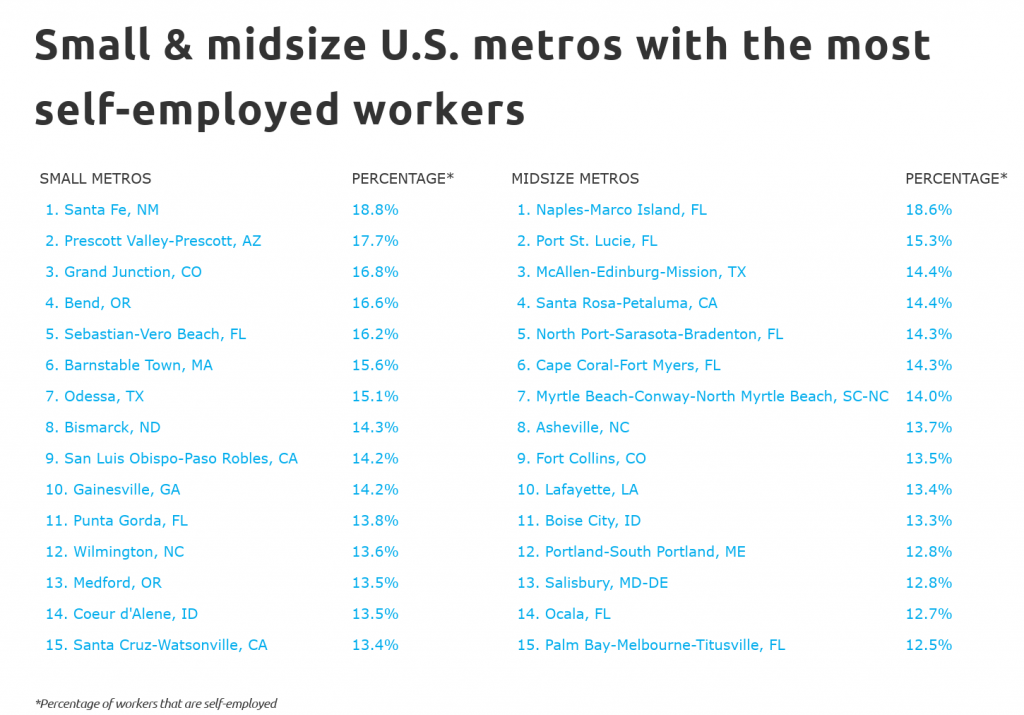
Large U.S. Metros With the Most Self-Employed Workers

Photo Credit: Sean Pavone / Shutterstock
15. Houston-The Woodlands-Sugar Land, TX
- Percentage of workers that are self-employed: 10.4%
- Total self-employed workers: 350,713
- Median income for full-time self-employed workers: $50,000
- Median income for all full-time workers: $50,000
- Population: 7,206,841

Photo Credit: f11photo / Shutterstock
14. San Antonio-New Braunfels, TX
- Percentage of workers that are self-employed: 10.5%
- Total self-employed workers: 126,262
- Median income for full-time self-employed workers: $45,000
- Median income for all full-time workers: $45,000
- Population: 2,601,788

Photo Credit: Sean Pavone / Shutterstock
13. Oklahoma City, OK
- Percentage of workers that are self-employed: 10.6%
- Total self-employed workers: 72,666
- Median income for full-time self-employed workers: $40,000
- Median income for all full-time workers: $45,000
- Population: 1,441,647

Photo Credit: f11photo / Shutterstock
12. Atlanta-Sandy Springs-Alpharetta, GA
- Percentage of workers that are self-employed: 10.6%
- Total self-employed workers: 323,989
- Median income for full-time self-employed workers: $50,000
- Median income for all full-time workers: $54,000
- Population: 6,144,050

Photo Credit: Andrew Zarivny / Shutterstock
11. Portland-Vancouver-Hillsboro, OR-WA
- Percentage of workers that are self-employed: 10.9%
- Total self-employed workers: 137,893
- Median income for full-time self-employed workers: $59,000
- Median income for all full-time workers: $60,000
- Population: 2,511,612

Photo Credit: Andrew Zarivny / Shutterstock
10. Denver-Aurora-Lakewood, CO
- Percentage of workers that are self-employed: 10.9%
- Total self-employed workers: 177,204
- Median income for full-time self-employed workers: $62,000
- Median income for all full-time workers: $60,000
- Population: 2,972,566

Photo Credit: Bogdan Vacarciuc / Shutterstock
9. San Francisco-Oakland-Berkeley, CA
- Percentage of workers that are self-employed: 10.9%
- Total self-employed workers: 256,567
- Median income for full-time self-employed workers: $70,000
- Median income for all full-time workers: $82,000
- Population: 4,623,264
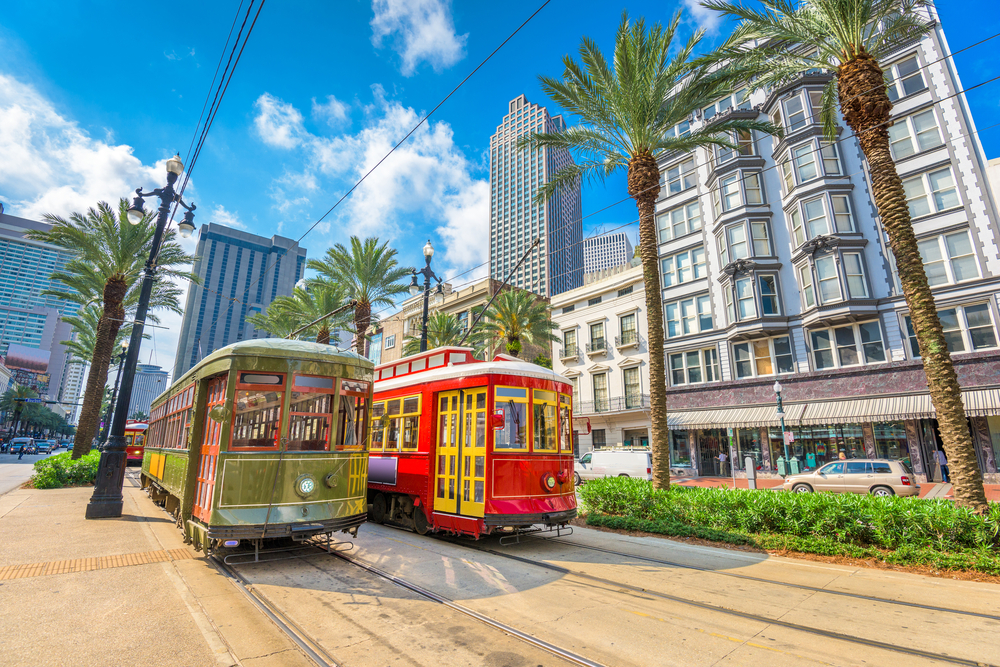
Photo Credit: Sean Pavone / Shutterstock
8. New Orleans-Metairie, LA
- Percentage of workers that are self-employed: 11.0%
- Total self-employed workers: 62,112
- Median income for full-time self-employed workers: $48,000
- Median income for all full-time workers: $50,000
- Population: 1,261,726

Photo Credit: Dancestrokes / Shutterstock
7. San Diego-Chula Vista-Carlsbad, CA
- Percentage of workers that are self-employed: 11.0%
- Total self-employed workers: 169,080
- Median income for full-time self-employed workers: $52,000
- Median income for all full-time workers: $59,000
- Population: 3,286,069
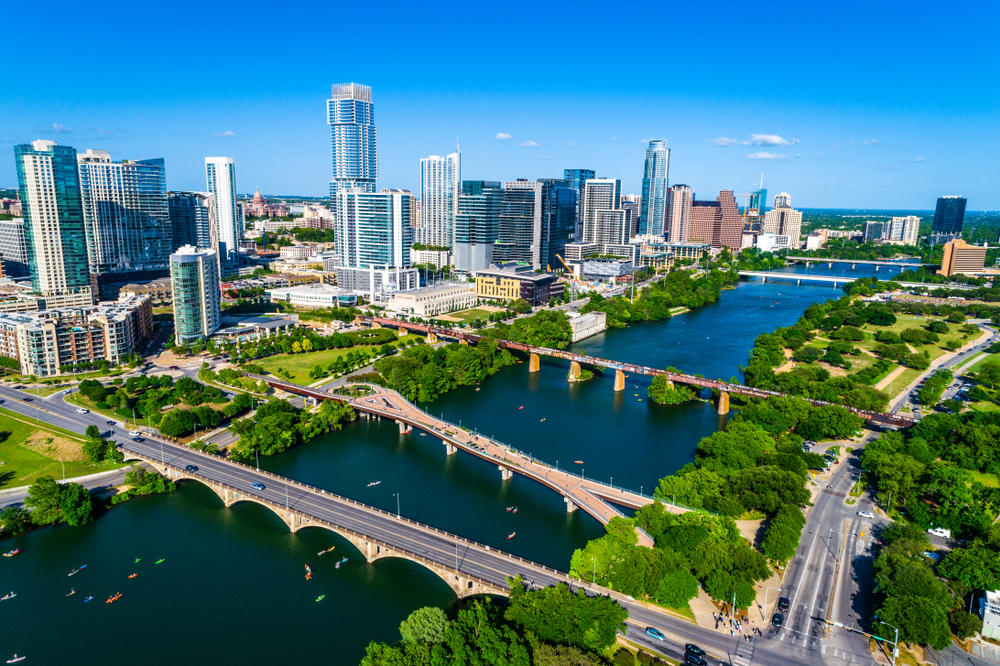
Photo Credit: Roschetzky Photography / Shutterstock
6. Austin-Round Rock-Georgetown, TX
- Percentage of workers that are self-employed: 11.2%
- Total self-employed workers: 142,711
- Median income for full-time self-employed workers: $60,000
- Median income for all full-time workers: $60,000
- Population: 2,352,426
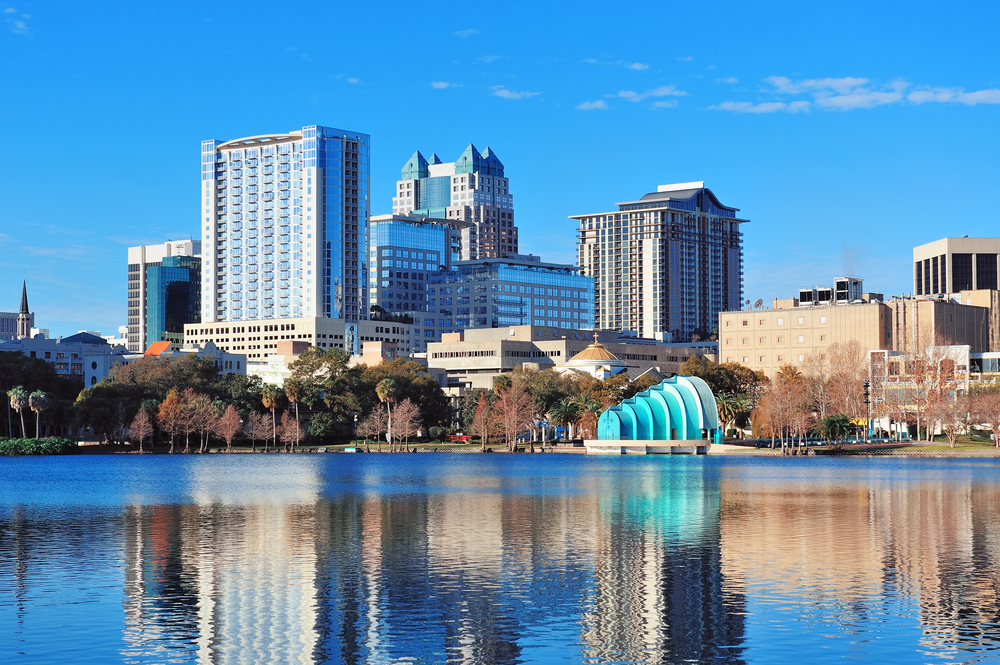
Photo Credit: Songquan Deng / Shutterstock
5. Orlando-Kissimmee-Sanford, FL
- Percentage of workers that are self-employed: 11.2%
- Total self-employed workers: 145,480
- Median income for full-time self-employed workers: $50,000
- Median income for all full-time workers: $45,000
- Population: 2,691,925

Photo Credit: Henryk Sadura / Shutterstock
4. Tampa-St. Petersburg-Clearwater, FL
- Percentage of workers that are self-employed: 11.5%
- Total self-employed workers: 175,962
- Median income for full-time self-employed workers: $50,000
- Median income for all full-time workers: $48,000
- Population: 3,219,514

Photo Credit: Steve Heap / Shutterstock
3. Nashville-Davidson–Murfreesboro–Franklin, TN
- Percentage of workers that are self-employed: 11.6%
- Total self-employed workers: 120,898
- Median income for full-time self-employed workers: $50,000
- Median income for all full-time workers: $50,000
- Population: 2,012,476

Photo Credit: Sean Pavone / Shutterstock
2. Los Angeles-Long Beach-Anaheim, CA
- Percentage of workers that are self-employed: 13.2%
- Total self-employed workers: 820,969
- Median income for full-time self-employed workers: $50,000
- Median income for all full-time workers: $53,000
- Population: 12,997,353
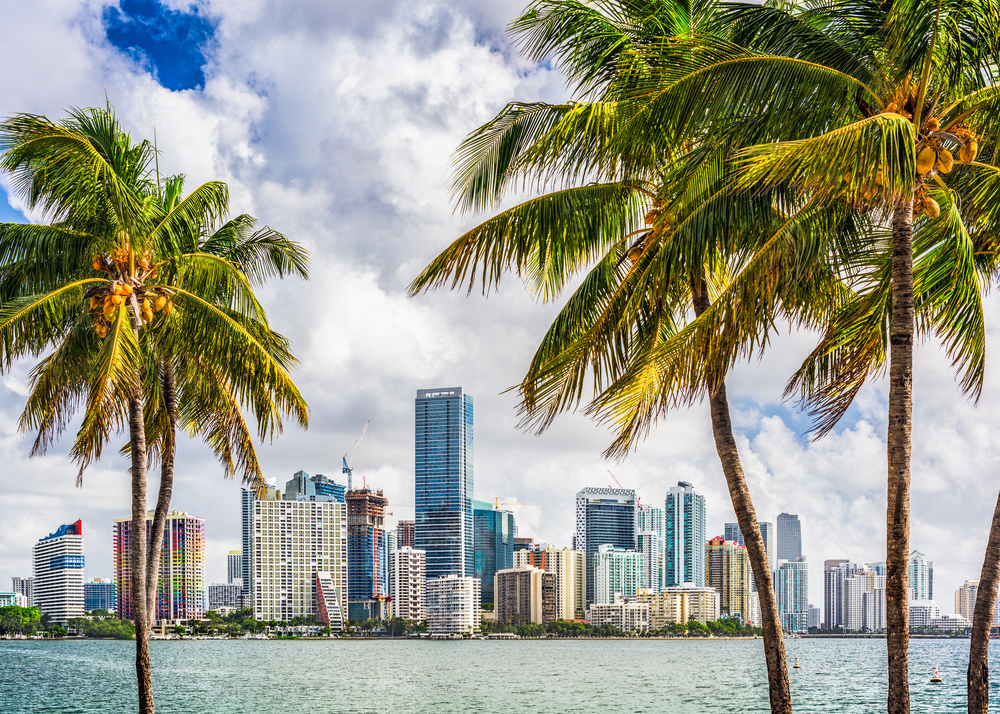
Photo Credit: Sean Pavone / Shutterstock
1. Miami-Fort Lauderdale-Pompano Beach, FL
- Percentage of workers that are self-employed: 15.8%
- Total self-employed workers: 468,070
- Median income for full-time self-employed workers: $40,000
- Median income for all full-time workers: $44,200
- Population: 6,091,747
Detailed Findings & Methodology
To find the metropolitan areas with the most self-employed workers, researchers at Self Financial analyzed the latest data from the U.S. Census Bureau’s 2021 American Community Survey. The researchers ranked metro areas according to the percentage of workers that are self-employed. In the event of a tie, the metro with the larger number of self-employed workers was ranked higher. Researchers also calculated the median income for full-time self-employed workers and the median income for all full-time workers using data from 2020, the latest available.
To improve relevance, only metropolitan areas with at least 100,000 people were included in the analysis. Additionally, metro areas were grouped into the following cohorts based on population size:
- Small metros: 100,000–349,999
- Midsize metros: 350,000–999,999
- Large metros: more than 1,000,000



